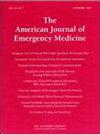Severe kava withdrawal managed with phenobarbital
IF 2.2
3区 医学
Q1 EMERGENCY MEDICINE
引用次数: 0
Abstract
Piper methysticum, known as “kava”, is a plant endemic to and historically consumed in the Pacific islands. The roots contain psychoactive kavalactones with sedating and anxiolytic effects. While often marketed for anxiety or as a safe alcohol alternative, dermopathy and more rarely hepatotoxicity are well described with heavy use. Reports of withdrawal are rare.
The leaves of Mitragyna speciosa, also referred to as “kratom”, contain psychoactive alkaloids with interactions at μ and δ-opioid receptors. Kratom is commonly used for its stimulant and opioid-like effects, for which dependence and withdrawal are much more well documented.
A 45-year-old man presented to the emergency department (ED) with auditory and visual hallucinations, anxiety, insomnia, and diffuse muscle jerking. He had been heavily using a supplemental beverage containing both kava and kratom, but stopped several days prior. His primary physician initiated buprenorphine therapy for suspected kratom withdrawal. Bedside evaluation in the ED was concerning for ongoing GABAergic withdrawal in the setting of kava use. Phenobarbital was given with significant improvement in symptoms, with eventual transition to diazepam. He was discharged home several days later in good condition.
Given the increasing popularity of herbal supplements including kratom, and more uncommonly kava, clinicians should be aware of their potential for abuse, dependence and severe withdrawal syndromes. Kratom may be managed in a fashion analogous to that of an opioid. While kava's pharmacologic properties remain poorly understood, withdrawal may be severe enough to warrant hospitalization. Phenobarbital or benzodiazepines may be considered as a potential therapeutic approach.
用苯巴比妥治疗严重的卡瓦戒断。
胡椒,俗称“卡瓦”,是一种太平洋岛屿特有的植物,历史上在太平洋岛屿上消费。根含有具有镇静和抗焦虑作用的精神活性的卡瓦内酯。虽然经常作为焦虑或安全的酒精替代品销售,但大量使用的皮肤病和更罕见的肝毒性被描述得很好。撤资的报道很少。Mitragyna speciosa,也被称为“kratom”,含有与μ和δ-阿片受体相互作用的精神活性生物碱。克拉托姆因其兴奋剂和类阿片作用而被广泛使用,对其依赖和戒断的记录更为充分。一名45岁男性因听觉和视觉幻觉、焦虑、失眠和弥漫性肌肉抽搐而被送往急诊室。他一直在大量使用一种含有卡瓦和克拉托姆的补充饮料,但几天前停了下来。他的主治医生开始丁丙诺啡治疗疑似kratom戒断。急诊科的床边评估是关于在使用卡瓦的情况下持续的gaba能戒断。给予苯巴比妥后症状有明显改善,最终改用安定。几天后,他出院回家,身体状况良好。鉴于草药补充剂的日益普及,包括kratom和更不常见的kava,临床医生应该意识到它们可能被滥用、依赖和严重的戒断综合征。可以类似于阿片类药物的方式管理克拉通。虽然卡瓦的药理学特性仍然知之甚少,但戒断可能严重到需要住院治疗。苯巴比妥或苯二氮卓类药物可能被认为是一种潜在的治疗方法。
本文章由计算机程序翻译,如有差异,请以英文原文为准。
求助全文
约1分钟内获得全文
求助全文
来源期刊
CiteScore
6.00
自引率
5.60%
发文量
730
审稿时长
42 days
期刊介绍:
A distinctive blend of practicality and scholarliness makes the American Journal of Emergency Medicine a key source for information on emergency medical care. Covering all activities concerned with emergency medicine, it is the journal to turn to for information to help increase the ability to understand, recognize and treat emergency conditions. Issues contain clinical articles, case reports, review articles, editorials, international notes, book reviews and more.

 求助内容:
求助内容: 应助结果提醒方式:
应助结果提醒方式:


